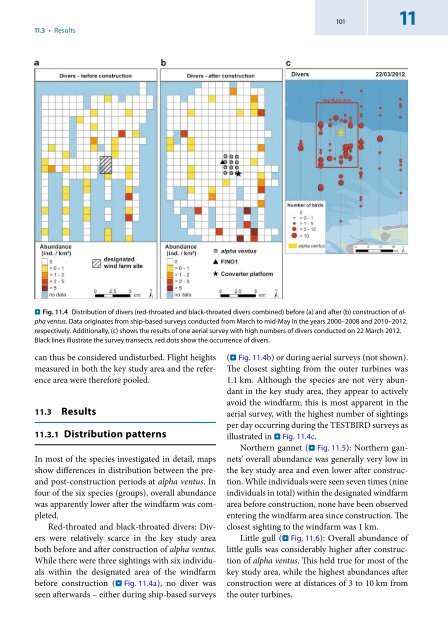bok%3A978-3-658-02462-8.pdf?auth66=1398409209_a0514c2b8e531c058ab8b810a0cad74d&ext=
bok%3A978-3-658-02462-8.pdf?auth66=1398409209_a0514c2b8e531c058ab8b810a0cad74d&ext=
bok%3A978-3-658-02462-8.pdf?auth66=1398409209_a0514c2b8e531c058ab8b810a0cad74d&ext=
- No tags were found...
You also want an ePaper? Increase the reach of your titles
YUMPU automatically turns print PDFs into web optimized ePapers that Google loves.
11.3 • Results101 11..Fig. 11.4 Distribution of divers (red-throated and black-throated divers combined) before (a) and after (b) construction of alphaventus. Data originates from ship-based surveys conducted from March to mid-May in the years 2000–2008 and 2010–2012,respectively. Additionally, (c) shows the results of one aerial survey with high numbers of divers conducted on 22 March 2012.Black lines illustrate the survey transects, red dots show the occurrence of divers.can thus be considered undisturbed. Flight heightsmeasured in both the key study area and the referencearea were therefore pooled.11.3 Results11.3.1 Distribution patternsIn most of the species investigated in detail, mapsshow differences in distribution between the preandpost-construction periods at alpha ventus. Infour of the six species (groups), overall abundancewas apparently lower after the windfarm was completed.Red-throated and black-throated divers: Diverswere relatively scarce in the key study areaboth before and after construction of alpha ventus.While there were three sightings with six individualswithin the designated area of the windfarmbefore construction (. Fig. 11.4a), no diver wasseen afterwards – either during ship-based surveys(. Fig. 11.4b) or during aerial surveys (not shown).The closest sighting from the outer turbines was1.1 km. Although the species are not very abundantin the key study area, they appear to activelyavoid the windfarm; this is most apparent in theaerial survey, with the highest number of sightingsper day occurring during the TESTBIRD surveys asillustrated in . Fig. 11.4c.Northern gannet (. Fig. 11.5): Northern gannets’overall abundance was generally very low inthe key study area and even lower after construction.While individuals were seen seven times (nineindividuals in total) within the designated windfarmarea before construction, none have been observedentering the windfarm area since construction. Theclosest sighting to the windfarm was 1 km.Little gull (. Fig. 11.6): Overall abundance oflittle gulls was considerably higher after constructionof alpha ventus. This held true for most of thekey study area, while the highest abundances afterconstruction were at distances of 3 to 10 km fromthe outer turbines.




